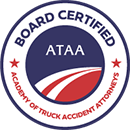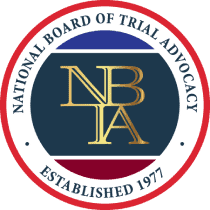Tips for Driving Safely Around Commercial Trucks
Large commercial motor vehicles (CMVs)—typically referred to as big rigs, semi-trucks, tractor-trailers, or 18-wheelers—are an unmistakable presence on the road. They’re over 70 feet long, weigh 20 times as much as a car, and tower up to 14 feet high.
No other vehicle on the road comes close in terms of how much damage a CMV can cause when it crashes.
If you’re like most of us, sharing the highway with these colossal transporters can be intimidating, to say the least. While you can’t control the actions of others, you can do your part to make smart, safe choices behind the wheel.
Below, we offer our top tips for driving safely around commercial trucks.
Beware of “No-Zones”
The term “No-Zones” refers to the four blind spots around a truck that you should never linger in for any amount of time.
When driving around commercial trucks, avoid the areas:
- 30 feet behind the trailer
- 20 feet in front of the truck cab
- One lane to the driver’s left, extending at least half the length of the trailer
- Two lanes to the driver’s right, extending the full length of the trailer
A good rule of thumb is to look for the truck driver’s face in a mirror. If you can’t see the driver’s face, they can’t see you.
Remember that your vehicle will disappear inside a No-Zone. Give the truck plenty of clearance and only travel through a No-Zone when you have given an indication and are passing the CMV.
Pass Safely
Do you know how to pass a truck safely? If you need to overtake a tractor-trailer on the highway, make sure that you:
- Remain visible to the truck driver as long as possible
- Indicate your plan to pass with a turn signal while still visible to the truck
- Move to the left lane and pass at a reasonable speed
- Do not remain in the blind spot for an extended period
- Move back to the right lane only when you have cleared the No-Zone in front of the truck cab and can see the vehicle in your rearview mirror
- Do not cut in close to the front of the truck when moving back to the right lane
Remember a Truck’s Braking Distance
One of the reasons it’s so important to avoid cutting in close in front of a truck is related to a CMV’s braking distance.
A large truck needs much more space to come to a stop after hitting the brakes. If a truck attempts to pull a hard stop when cut off, it could cause a rear-end collision with vehicles in front of or behind it.
A fully-loaded commercial truck needs about 500 to 600 feet to come to a stop from 65 mph. A passenger car usually only requires about 300 to 350 feet. These numbers can also be affected by weather and road conditions.
Keep a truck’s increased braking distance in mind when navigating near one on the road or highway. Never tailgate a truck, and make sure to leave ample room between your back bumper and the front of a big rig.
Watch Out for Wide Turns
One of the most dangerous things you can do as a passenger vehicle driver is to try to squeeze past a turning truck.
Trucks need a wide angle of rotation when making turns, especially right turns. To execute a turn, a trucker may need to move the vehicle into the left lane to complete the right turn. If a driver attempts to pass the truck on the right while this is happening, they can become caught between the trailer and the curb in what is referred to as a “squeeze play” accident.
It’s also dangerous to pass a truck on the left during a turn, as you may not realize a truck’s body is shifting into the lane.
The best way to handle truck turns is to be patient. Allow the truck to complete the turn and continue on its way before moving forward. Being a few minutes late for work is always better than not making it there at all.
Make Sure You’re the Safest Driver on the Road
Only you can control your driving behaviors. No matter what others are doing, you’re responsible for your own actions.
It may be common sense, but it’s easy to forget some of the basic rules for safe driving. These rules are even more important when large commercial trucks are nearby.
- Always wear a seatbelt
- Never operate a cell phone while driving
- Avoid all driving distractions and give 100% of your focus to the road
- Never drink and drive
- Exercise extra care at night and in weather conditions like rain, snow, fog, sleet, and high wind
- Follow the speed limit and adjust to a slower speed as conditions warrant
Know Your Rights if You’re Involved in a Truck Crash
Despite any precautions you may take, accidents still happen. And when they involve trucking negligence, they aren’t accidents at all. They’re preventable consequences of poor choices that are usually motivated by business goals over motorist safety.
Being injured in a truck accident caused by negligent behavior is something nobody wants to face. Trucking Injury Law Group was formed to give victims of truck crashes the best chance at recovery, justice, financial stability, and peace of mind knowing that trucking misconduct is not going unchecked.
Contact our nationwide trucking injury law group to speak with a board-certified member of our Super Team. We offer free consultations to truck crash survivors looking for legal guidance.






